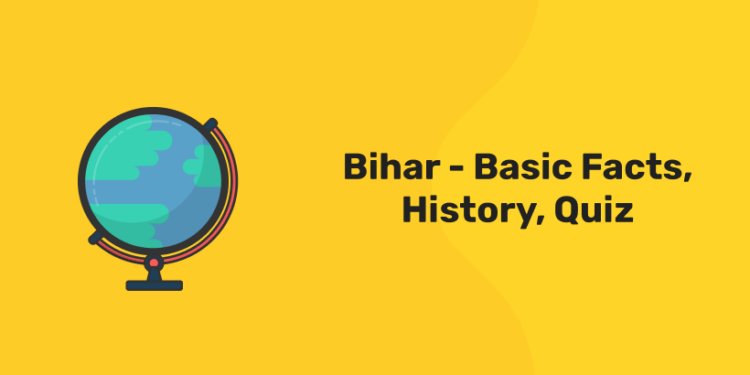Table of Contents
Bihar is a state in eastern India. Nepal borders it on the north, West Bengal on the east, and the Indian states of Uttar Pradesh and West Bengal on the west. In November 2000, the state of Jharkhand was founded from Bihar’s southern provinces, and it now encompasses the state’s southern and southeastern borders. Patna is the capital of Bihar.
Bihar was a crucial part of India’s early history. For centuries, it was the seat of imperial power and the epicentre of Indian culture and civilization. Bihar is derived from the Sanskrit vihara (Buddhist monastery), emphasising the historical significance of such communities in the area. The state is divided into two parts by the Ganges (Ganga) River: the North Bihar Plains and the South Bihar Plains, which together form the middle Gangetic Plain. The North Bihar Plain is a flat alluvial region that is less than 250 feet (75 metres) above sea level and prone to floods, with the exception of the Himalayan foothills in the extreme northwest. The Ghaghara, Gandak, Baghmati, Kosi, Mahananda, and other rivers flow down from the Himalayas of Nepal, changing channels along the way to the Ganges.
Depressions and lakes can be found along the abandoned streams. Man-made embankments have kept the Kosi River, termed “Bihar’s Sorrow” because of its tendency for causing deadly floods, in check. New alluvium dominates the northern plain’s soil, which is chalky and light-textured (mainly sandy loam) west of the Burhi (Old) Gandak River and nonchalky and heavy-textured (clay and clay loam) east of it. Seismic activity, which occurs throughout the Himalayan earthquake zone, is a natural hazard in this area. The earthquakes of 1934 and 1988 were particularly powerful, wreaking havoc and killing a large number of people.
Learn and gain knowledge about intriguing topics using the Entri App.
Bihar: History
Bihar has the most intriguing history of all the states. There are three distinct regions in this state, each with its own history and culture. India’s Magadh, Mithila, and Bhojpur are three states. Bihar was a crucial part of India’s early history. For centuries, it served as the imperial capital and the epicentre of Indian culture and civilization. This polity was the seat of multiple mighty kingdoms and a major centre of scholarship for thousands of years.
On the plains of Bihar, many kingdoms arose during the early Vedic era. Videha governed the land north of the Ganges, and was the father of Princess Sita, Lord Rama’s wife and the central figure of the Ramayana, one of India’s two great Hindu epic novels. During the reign of the ancient kingdom of Magadha, Rajagriha was the capital (now Rajgir).
Pataliputra (modern-day Patna) was the capital of the Magadha kingdom from roughly 475 BCE until the invasion of the Hephthalites from the north in the middle and late 5th century CE, when it fell to Ashoka and the Guptas. In the 6th–7th centuries, the Son River’s migration destroyed this city; the Chinese explorer Xuanzang wrote that the city had few people in 637. During this time, this polity regained its glory, but it is improbable that it ever served as the Pala empire’s capital (which lasted from about 775 to 1200). During the Muslim period, Bihar experienced a brief time of independence (about 1200 to 1765).This important unit remained under British authority until 1765, when it was amalgamated with the state of Bengal, along with Chota Nagpur to the south.
Bihar is a patriotic state that produced numerous patriots who fought for India’s independence. In the Champaran district of northern Bihar, Bapu or Mahatma Gandhi Ji, the nationalist leader who promoted nonviolent resistance, led the legendary Satyagraha movement against the tyranny of the European indigo planters. Dr. Rajendra Prasad was born in the Siwan area (formerly a part of the Saran district), northwest of Patna, and was elected the first president of independent India.
Chota Nagpur used to be a huge forest area controlled by tribal chieftains. Despite the fact that British authority in the plains to the north began to establish itself in the second half of the 18th century and the beginning of the 19th century, Chota Nagpur saw periodic revolts against the British, the most notable of which were the Ho revolt of 1820 to 1827 and the Munda uprising of 1831 to 1832. Bihar afterwards became an imperial hotspot during the Indian Mutiny in 1857–58. Bihar and Orissa were part of the Bengal Presidency when they were established under British control, but they became separate provinces of British-ruled India in 1936.
History of Bihar After Independence
After independence in 1947, Bihar became a constituent part of India, and minor states with headquarters in Saraikela and Kharsawan were merged with it in 1948. A portion of 3,140 square miles (8,130 square kilometres) was shifted from Bihar to West Bengal when India’s states were divided up linguistically in 1956. The Chota Nagpur plateau in Bihar’s southern region became part of the newly established state of Jharkhand in 2000, for the first time after independence, a state administration was elected from a party other than the one in power at the national level.
Bihar: Interesting Facts
1: Who was the first woman President of India?
Here are some fascinating Bihar facts:
- Buddhism and Jainism, the world’s two greatest religions, were both born in Bihar. Thanks to the efforts of these monks, Buddhism spread throughout the world.
- The word “Bihar” is derived from the Sanskrit and Pali words “Vihara,” which meaning “dwelling.” During the ancient and mediaeval ages, Buddhist monks populated much of the surrounding lands. As a result, the state’s name came to be associated with the abode or home of the Buddhist monks who lived there.
- Nonviolence is estimated to have started around 2600 years ago in Bihar. The Great, Lord Buddha, and Lord Mahavir all promoted this fascinating idea.
- The world-famous Nalanda University is located in Patna, the capital city. It is one of the world’s oldest universities and was formerly thought to be a knowledge storehouse. Iran, Japan, Greece, China, and Korea are just a few of the countries represented. The Nalanda library is said to have been burned on fire by BakhtiyarKhilji’s troops. The library was reported to contain 9 million manuscripts, and it took three months to burn to ashes.
- India’s oldest Hindu temple is said to be the Mundeshwari temple in Bihar. In this temple, Lord Shiva and his wife, Shakti, are both revered. On the other hand, the four-headed Shiv god is continually surrounded by a vast crowd with the sound of bells ringing in the background.
- Indian politics are intrinsically related to Bihar. India’s first president, Dr. Rajendra Prasad, was born in Bihar. Jai Prakash Narayan, Lalu Prasad Yadav, and Nitish Kumar are all well-known politicians from Bihar.
- Bihar has generated a considerable number of Indian Administrative Service (IAS) personnel. In terms of the number of IAS officers it has produced, it is regarded as the second most important state. Gujarat, Kerala, Karnataka, Andhra Pradesh, and Tamil Nadu, in fact, have produced less IAS officials than Bihar.
- The tomb of Mughal ruler Sher Shah Suri and the Maner Sharif are also architectural marvels. The Mahabodhi temple at Bodh Gaya attracts a large number of visitors.
- Chandragupta Maurya, Samudragupta, Vikramaditya, and Ashoka the Great were all born in Bihar.
- Anand Kumar is a mathematics genius from Patna, Bihar, who is well known for his Super 30 software. His Super 30 programme trains economically disadvantaged kids for the IIT-JEE, the Indian Institutes of Technology’s entrance exams (IITs). He has been invited to lecture at the prestigious Massachusetts Institute of Technology (MIT) and Harvard University on his laudable endeavours. His work has even been featured in a documentary on the Discovery Channel.
Free UPSKILLING Courses!
Take your first step toward mastering in-demand skills, acing interviews, and securing top-tier jobs with Entri's free upskilling courses.
Start Learning!Bihar: Quiz
Q.1.Which of the following state shares a southern border with Bihar?
- Uttarpradesh
- West Bengal
- Jharkhand
- None of these
Answer: 3. Jharkhand
Q.2.Which flower has been designated as the state flower?
- Rose
- Jasmine
- Tulip
- Marigold
Answer: 4. Marigold
Q.3.In which year was Bihar separated from the Bengal Presidency?
- 1912
- 1921
- 1935
- 1948
Answer: 1. 1912
Q.4.In the Indian state of Bihar, which of the following is the only UNESCO World Heritage Site?
- Mahabodhi Vihar
- Buddhist monastery in Nalanda
- Ancient site of Vikramashila Monastery
- Tomb of Sher Shah Suri
Answer: 1. Mahabodhi Vihar
Q.5.Which other official language of Bihar is there besides Hindi and Urdu?
- Bhojpuri
- Maithili
- Magadhi
- Sanskrit
Answer: 2. Maithili
Q.6.North Bihar is famous for
- Agricultural prosperity
- Heavy industries
- Flood
- Famine
Answer: 3. Flood
Q.7.In 1974, who was the student movement’s leader in Bihar?
- Jai Prakash Narayan
- Ram Manohar Lohia
- Vinoba Bhave
- Ram Pujan Sahay
Answer: 1. Jai Prakash Narayan
Q.8.Bihar’s Dalmianagar is well-known for
- Silk
- Jute
- Leather
- Cement
Answer: 4. Cement
Q.9.Bihar’s famous “Sonepur Cattle Fair” is held at the confluence of which two rivers?
- Ganges and Gandak
- Ganges and Kosi
- Mahananda and Gandak
- Gandak and Kosi
Answer: 1. Ganges and Gandak
Q.10.To the west of Bihar is which state?
- Orissa
- Uttar Pradesh
- Nagaland
- Arunachal Pradesh
Answer: 2. Uttar Pradesh













